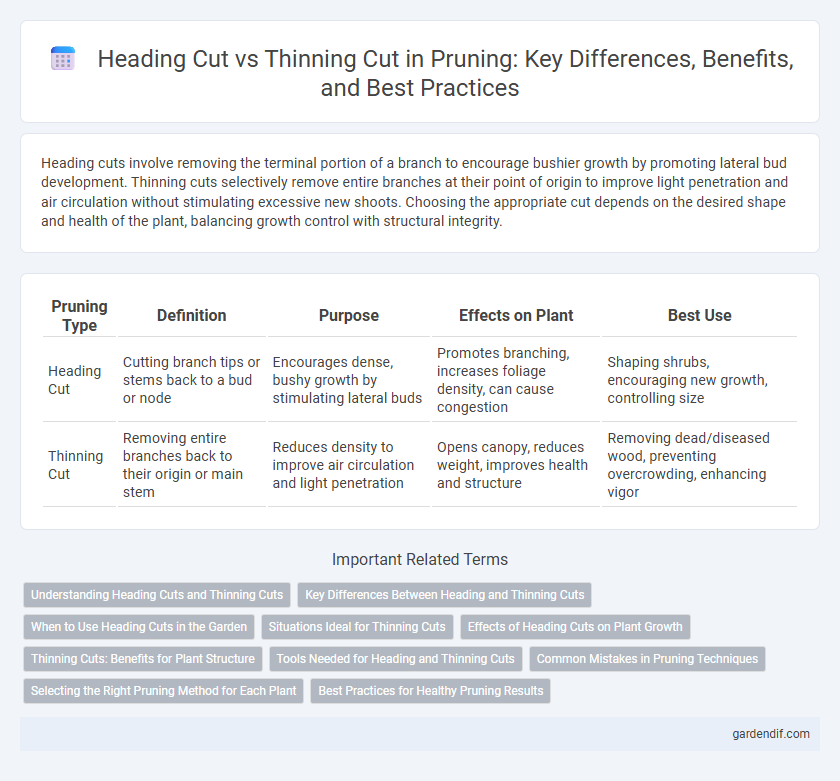
Heading cut vs thinning cut Illustration
Heading cuts involve removing the terminal portion of a branch to encourage bushier growth by promoting lateral bud development. Thinning cuts selectively remove entire branches at their point of origin to improve light penetration and air circulation without stimulating excessive new shoots. Choosing the appropriate cut depends on the desired shape and health of the plant, balancing growth control with structural integrity.
Table of Comparison
| Pruning Type | Definition | Purpose | Effects on Plant | Best Use |
|---|---|---|---|---|
| Heading Cut | Cutting branch tips or stems back to a bud or node | Encourages dense, bushy growth by stimulating lateral buds | Promotes branching, increases foliage density, can cause congestion | Shaping shrubs, encouraging new growth, controlling size |
| Thinning Cut | Removing entire branches back to their origin or main stem | Reduces density to improve air circulation and light penetration | Opens canopy, reduces weight, improves health and structure | Removing dead/diseased wood, preventing overcrowding, enhancing vigor |
Understanding Heading Cuts and Thinning Cuts
Heading cuts remove the terminal portion of a stem or branch, stimulating vigorous new growth by cutting just above a bud or side branch; this method encourages denser foliage and a more compact shape. Thinning cuts eliminate entire branches or stems at their point of origin, reducing density without stimulating excessive regrowth, thus improving light penetration and air circulation in the canopy. Understanding the difference between heading cuts and thinning cuts is essential for effective pruning strategies that balance growth control and plant health.
Key Differences Between Heading and Thinning Cuts
Heading cuts involve cutting a branch back to a bud or a stub, stimulating dense, compact growth and shaping the plant by encouraging lateral branching. Thinning cuts remove entire branches at their point of origin, reducing density without stimulating excessive new growth, thus maintaining the plant's natural form and improving air circulation. The key difference lies in heading cuts promoting bushiness and thinning cuts maintaining structure and health by decreasing overcrowding.
When to Use Heading Cuts in the Garden
Heading cuts are ideal when you want to control the size of a plant, encourage bushier growth, or stimulate new shoots in specific areas of the garden. Use heading cuts on young branches or stems to promote dense foliage and a more compact shape. This technique is particularly effective for shaping shrubs, hedges, and encouraging flower production on certain plants.
Situations Ideal for Thinning Cuts
Thinning cuts are ideal for reducing canopy density without altering the tree's natural shape, promoting better light penetration and air circulation in crowded or overgrown branches. This technique is commonly used in fruit trees and ornamental plants to improve fruit quality and overall plant health. Thinning cuts remove entire branches at their point of origin, minimizing the risk of disease and encouraging balanced growth.
Effects of Heading Cuts on Plant Growth
Heading cuts stimulate vigorous shoot growth by removing the apical dominance, causing numerous lateral buds to break dormancy and produce dense foliage. This intense regrowth can lead to a bushier plant structure but may reduce overall plant height and redirect energy from root development to shoot proliferation. The rapid proliferation of shoots after heading cuts often requires additional maintenance to manage increased plant density and maintain airflow.
Thinning Cuts: Benefits for Plant Structure
Thinning cuts enhance plant structure by selectively removing branches at their origin, reducing density without stimulating excessive regrowth. This method improves air circulation and light penetration, promoting healthier photosynthesis and reducing the risk of disease. Thinning cuts also maintain natural branch form, supporting long-term structural integrity and balanced growth.
Tools Needed for Heading and Thinning Cuts
Heading cuts require sharp pruning shears, loppers, or saws depending on branch thickness to effectively shorten branches and stimulate dense growth. Thinning cuts demand precision tools such as bypass pruners or thinning shears designed to remove entire branches cleanly without damaging surrounding tissue. Quality tools with sharp blades ensure clean cuts that minimize plant stress and promote healthy regrowth.
Common Mistakes in Pruning Techniques
Common mistakes in pruning include confusing heading cuts with thinning cuts, leading to excessive growth or poor branch structure. Heading cuts remove the terminal portion of a branch, often stimulating dense, bushy growth, while thinning cuts selectively remove entire branches to improve light penetration and air circulation. Misapplication of these cuts can result in weakened plant health, increased disease susceptibility, and an unbalanced canopy.
Selecting the Right Pruning Method for Each Plant
Choosing the right pruning method depends on the plant's growth habit and health; heading cuts stimulate dense, bushy growth by removing terminal buds, while thinning cuts improve air circulation and light penetration by selectively removing entire branches. Heading cuts are ideal for shaping and encouraging new shoots in shrubs, whereas thinning cuts maintain natural form and reduce disease risk in trees and mature plants. Understanding each plant's response to these techniques ensures optimal growth, vitality, and aesthetics.
Best Practices for Healthy Pruning Results
Heading cuts remove the terminal portion of a branch, stimulating dense, bushy growth near the cut site, while thinning cuts selectively remove entire branches to improve air circulation and light penetration within the canopy. Best practices for healthy pruning emphasize using thinning cuts to maintain natural tree structure and prevent overcrowding, combined with heading cuts sparingly to control size without compromising plant health. Proper timing, clean cuts, and sterilized tools reduce disease risk and promote rapid wound healing for optimal pruning results.
Heading cut vs thinning cut Infographic

 gardendif.com
gardendif.com